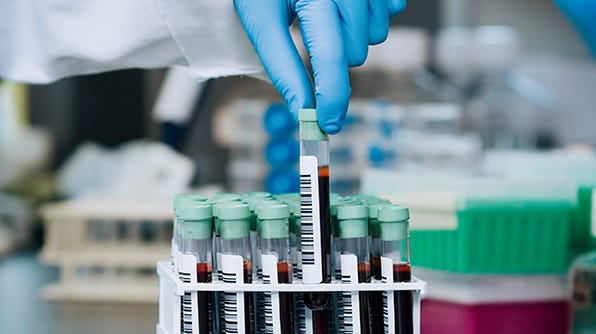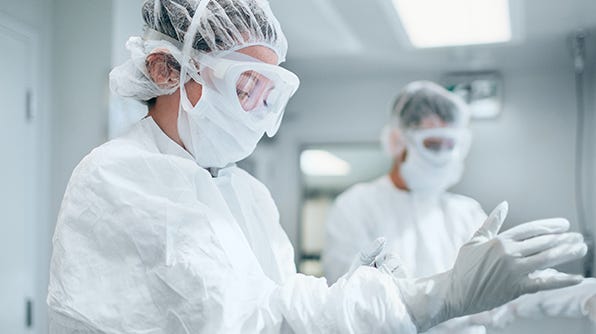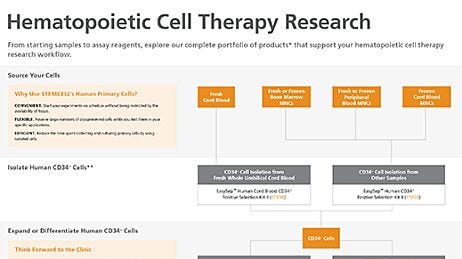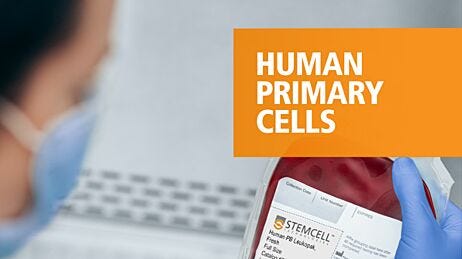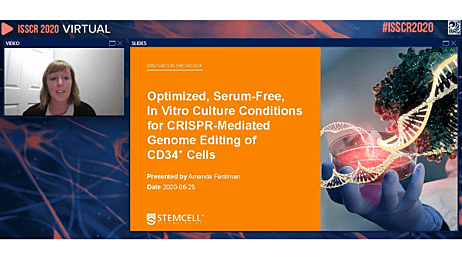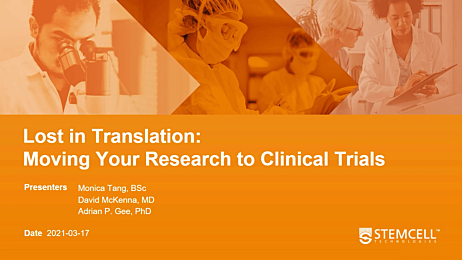Q&A: Efficient CD34⁺ Cell Genome Editing and HPSC Maintenance
CRISPR-Cas9 gene editing of human hematopoietic stem and progenitor cells (HSPCs) holds promise for treating disease, either through cellular therapy or other methodologies. A critical part of developing a treatment using genome-edited HSPCs involves implementing an optimized gene editing and cell culture methodology. In their on-demand webinar, “Optimizing CD34⁺ Cell Genome Editing for Efficiency and HSPC Maintenance”, STEMCELL experts Dr. Marta Walasek and Ms. Danielle Nguyen Truong provide an overview of HSPCs and CRISPR-Cas9 genome editing, and describe the work carried out at STEMCELL Technologies to define optimal culture conditions for an efficient genome editing workflow.
Continue reading to find answers from webinar speakers, Dr. Walasek and Ms. Nguyen Truong, along with Hematology Product Manager, Ms. Selena Hallahan, from STEMCELL to some of the questions that were posed following the live webinar in April 2022. They have also supplied references for further reading.
Meet the Speakers
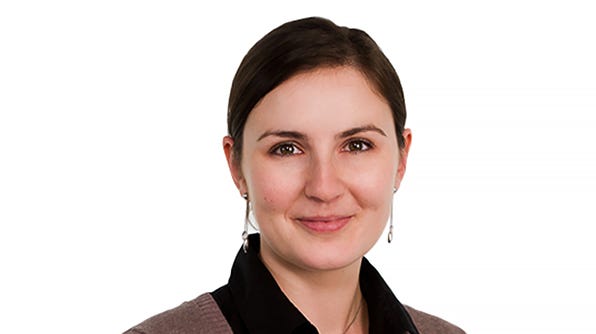
Dr. Marta Walasek
Dr. Marta Walasek is a Senior Scientist in the Hematology department at STEMCELL. She has over 10 years experience in the field of hematopoiesis and stem cell biology. Marta’s work focuses on the development of products for hematopoietic stem and progenitor cell expansion, differentiation, and readout.

Ms. Danielle Nguyen Truong
Danielle Truong is a Technical Scientist in the Business Operations department at STEMCELL. She has over 12 years experience in the field of molecular biology and genome editing. Danielle’s work focuses on protocol development of genome editing on a variety of cell types, including stem and primary cells, using ArciTect™ CRISPR-Cas9.
CD34⁺ cell sourcing and isolation
Can you speak to the difference between mobilized CD34⁺ cells and those from bone marrow if the desired end product is differentiated erythroid cells?
Can this culture system for CD34⁺ expansion be used for hPSC-derived CD34⁺ cells?
What is the usual CD34 purity using the EasySep™ system?
Frequently Asked Questions on Primary Cells
Have questions about sourcing CD34⁺ cells? Find answers to frequently asked questions about ready-to-use fresh or cryopreserved primary cells from STEMCELL.
CD34⁺ cell culture
How does the marker expression of CD34/CD90/CD45RA typically change over the first 4 - 7 days in culture?
Why is UM171 not available anymore?
Selena Hallahan (Product Manager, Hematology): UM171 was discontinued for sale by STEMCELL in October 2019 per the wishes of the patent holder.
Regarding the culture protocol outlined in the webinar, similar results are expected when using UM729 (Catalog #72332) prepared to a final concentration of 10X the concentration of UM171 (i.e. 1 μM). The equivalency of these molecules in expanding human cord blood cells has been shown by Fares and coworkers and confirmed by STEMCELL.
Please note that STEMCELL is the only authorized retailer of UM729. All other vendors are selling these products without the express permission of the patent holder.
Is UM171 used in place of StemSpan™ CD34⁺ Expansion Supplement or in addition to it?
Selena Hallahan: UM171 is the small molecule that was used in addition to StemSpan™ CD34⁺ Expansion Supplement (Catalog #02691).
Please note that UM171 is no longer available for sale by STEMCELL; however, similar results are expected when using UM729 (Catalog #72332) prepared to a final concentration of 1 μM.
Will the expansion media components interfere with HSPC differentiation?
Selena Hallahan: Culture conditions may impact the differentiation of HSPCs. The choice of growth factors and supplements added to the culture media affects whether the cell is stimulated to expand or differentiate. Early-acting cytokines and compounds that prevent differentiation can be used to expand HSPCs, whereas lineage-specific differentiation is achieved with the use of lineage-specific growth factors, such as erythropoietin (EPO) to stimulate erythroid differentiation.
StemSpan™ serum-free media have been developed to support the expansion and differentiation culture of hematopoietic cells and do not contain hematopoietic growth factors. This allows users the flexibility to supplement the medium with growth factors and/or other stimuli of choice to promote expansion or lineage-specific differentiation of HSPCs.
StemSpan™ expansion supplements are pre-mixed cocktails of recombinant human cytokines and other additives. Each has been formulated to selectively promote the expansion of CD34⁺ stem and progenitor cells, or to stimulate their differentiation into erythroid, myeloid (granulocyte or monocyte), or megakaryocyte progenitor cells, when added to StemSpan™ media.
Together, StemSpan™ media and supplements support greater expansion of CD34⁺ cells and differentiation of erythroid cells, granulocytes, monocytes, and megakaryocytes, than other media tested.
Removing Animal Components From Your HSPC Workflow
Watch as STEMCELL experts discuss how animal origin-free HSPC reagents can support optimized cell quality and reproducibility throughout your workflow, ultimately easing your path to the clinic.
What was the medium used when plating the pre-editing culture?
Dr. Marta Walasek: We tested various StemSpan™ media as well as alternative commercial media to identify optimal culture conditions for genome editing. While all StemSpan™ media and supplements were compatible with the genome editing workflow, we found that StemSpan™ SFEM II (Catalog #09605) supplemented with StemSpan™ CD34⁺ Expansion Supplement (Catalog #02691) and the small molecule, UM729 (Catalog #72332), for 2 days prior to CRISPR-Cas9 editing best supports maintenance of CD34 expression and expansion of primitive HSPC subsets during genome editing.
More information on the culture conditions tested can be found in this technical bulletin.
CRISPR-Cas9 gene editing of CD34⁺ cells
Have you ever coupled lentivirus infection of an sgRNA with electroporation of Cas9? If so, how do you recommend we do it?
Danielle Nguyen Truong: We have developed a protocol for genome editing using CRISPR-Cas9 with electroporation of the RNP system into CD34⁺ cells. We have not coupled lentivirus infection of an sgRNA with electroporation of Cas9. It has been shown that lentiviral transduction of Cas9 is less efficient in sensitive cell types such as HSPCs. More information about lentivirus infection of sgRNA with electroporation of Cas9 has been described by Yudovich and coworkers.
- Yudovich D et al. (2020) Combined lentiviral- and RNA-mediated CRISPR/Cas9 delivery for efficient and traceable gene editing in human hematopoietic stem and progenitor cells. Sci Rep 10: 22393.
Different types of donor templates can induce significantly different levels of cytotoxicity. Do you have any suggestions about electroporation conditions during AAV delivery?
Danielle Nguyen Truong: Homology-directed repair (HDR) efficiency is usually higher with short single-stranded oligodeoxynucleotide (ssODN) donor templates, which are often used to correct a single base change, or short insertions or deletions. HDR is less efficient when double-stranded (dsDNA) templates are introduced, and a high concentration of dsDNA can cause cytotoxicity in cells. Shy et al. developed a novel system that takes advantage of lower toxicity with single-stranded DNA (ssDNA), in which the hybrid ssDNA HDR templates were incorporated with Cas9 target sequences (CTS) to improve the knock-in efficiency and reduce toxicity in cells.
What is the delivery efficiency of the lentiviral system in CD34⁺ cells? What is the best viral vector for CD34⁺ cell transduction?
- Yudovich D et al. (2020) Combined lentiviral- and RNA-mediated CRISPR/Cas9 delivery for efficient and traceable gene editing in human hematopoietic stem and progenitor cells. Sci Rep 10: 22393.
- Uchida N et al. (2021) Cas9 protein delivery non-integrating lentiviral vectors for gene correction in sickle cell disease. Mol. Ther. Methods Clin. 21: 121–32
Do you ever isolate more purified HSPCs (i.e. additional markers to CD34) and perform RNP electroporation on a more purified population?
Danielle Nguyen Truong: The CRISPR gene-editing protocol presented in our webinar has been optimized using bulk CD34⁺ cell editing; it has not been tested on sorted and purified HSPC subsets. However, gene-editing efficiency of HSPC subsets during bulk CD34⁺ cell editing has been evaluated and the data showed efficient editing and maintenance of the CD34⁺CD45RA⁻CD90⁺ HSPC subset. Therefore, the presented genome editing protocol should be applicable when starting with purified HSPC subsets.
Gene editing of more purified HSPCs has been described in the literature. For example, in the paper below, Zonari et al. genome edited sorted CD34⁺CD38⁻ cells and suggested that such an approach may allow for better tailored gene transfer to LT-HSPCs.
- Zonari E et al. (2017) Efficient ex vivo engineering and expansion of highly purified human hematopoietic stem and progenitor cell populations for gene therapy. Stem Cell Rep: 8(4): 977–90.
Are the pre-editing CRISPR parameters the same as for lentivirus transduction?
Do both alleles get edited with the RNP electroporation?
If you'd like to confirm successful genome editing prior to transplantation of the cells, can you keep the cells in culture for 2 - 3 days before transplanting? Or is that too long to wait?
Danielle Nguyen Truong: Cells can be grown in culture for an additional 2 or 3 days before transplanting of the cells without any impact to editing efficiency. However, the cells need to be passaged if they are over-confluent to avoid overgrown cultures.
While longer cell culture may be required to confirm successful genome editing, the engraftment potential of the cells decreases with extended cell culture. It has been demonstrated that CD34⁺ cells retain engraftment potential following 6 - 7 days culture in optimal conditions and medium.
Have you used this genome editing system to generate knock-in (KI) cell lines?
Explore These Resources
Request Pricing
Thank you for your interest in this product. Please provide us with your contact information and your local representative will contact you with a customized quote. Where appropriate, they can also assist you with a(n):
Estimated delivery time for your area
Product sample or exclusive offer
In-lab demonstration
